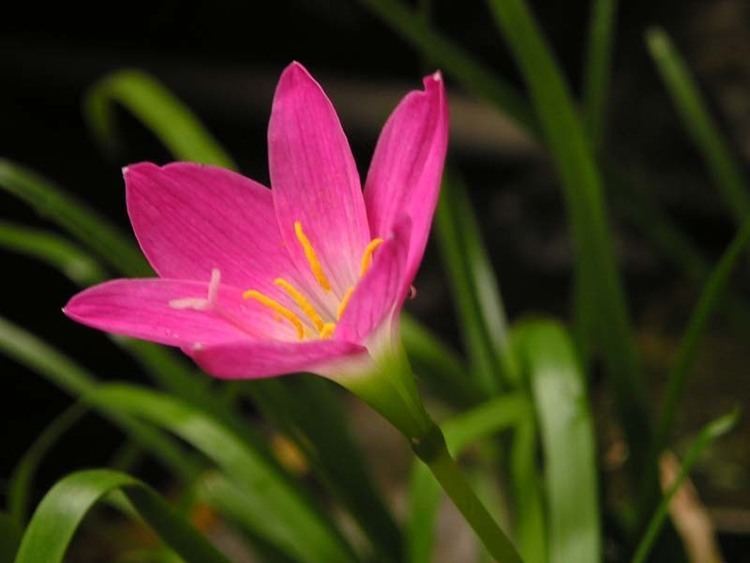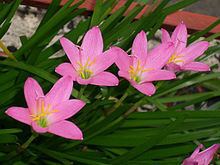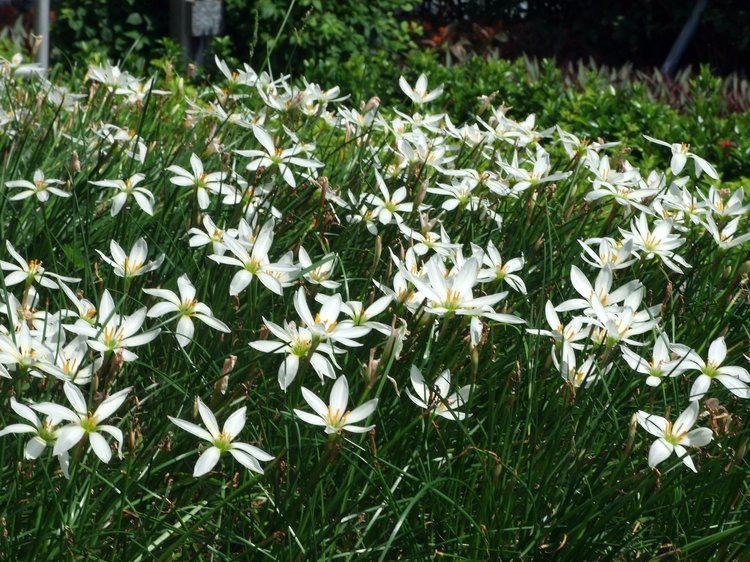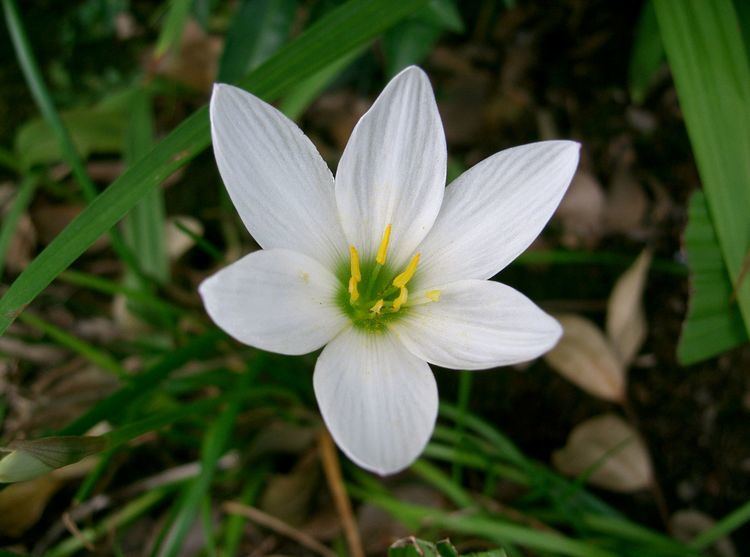Clade Monocots Scientific name Zephyranthes | Clade Angiosperms Family Amaryllidaceae Subtribe Zephyranthinae Rank Genus | |
 | ||
Lower classifications Zephyranthes candida, Zephyranthes minuta, Zephyranthes atamasca | ||
172 how to grow small pink lily pink rain lily zephyranthes candida hindi urdu 16 10 16
Zephyranthes /ˌzɛfᵻˈrænθiːz/ is a genus of temperate and tropical plants in the Amaryllis family, native to the Western Hemisphere and widely cultivated as ornamentals. There are over 70 recognized species species in the Amaryllis family (subfamily Amaryllidoideae). as well as numerous hybrids and cultivars. Common names for species in this genus include fairy lily, rainflower, zephyr lily, magic lily, Atamasco lily, and rain lily.
Contents
- 172 how to grow small pink lily pink rain lily zephyranthes candida hindi urdu 16 10 16
- Rain lily pond plants or garden plants zephyr zephyranthes candida
- Taxonomy
- Biology
- Morphology
- Flowers
- Cultivation
- Breeding
- Species
- Formerly placed here
- Named hybrids and cultivars
- References

The name is derived from Ζέφυρος (Zephyrus), the Greek god of the west wind, and ἄνθος (anthos), meaning flower, referring to the slender stalks.

Rain lily pond plants or garden plants zephyr zephyranthes candida
Taxonomy

According to Meerow et al., cladistics suggests that the genus is native to the Americas. Several species have become naturalized (sometimes unintentionally) in other places like Hawaii, Indonesia, and Thailand. The species that are native to the higher altitudes in Mexico (e.g. Z. lindleyana, Central America (Costa Rica, e.g. Z. carinata) and parts of North America (e.g. Z. longifolia) or Argentina (e.g. Z. candida) represent the species having the greatest potential for cold hardiness.
Biology

These perennial bulbs (geophytes) tolerate many ecological niches (periodically wet soil to desert conditions), and have many ornamental characteristics. Many parts of the plant including the leaves and bulbs are considered to be toxic. The genus has been evaluated for possible medicinal properties, and the biochemically toxic compounds are classed as alkaloids.
Morphology
Species in the genus which are listed in this article vary in morphology. Along with floral morphology, characteristics such as bulb size, bulb tunic color, and leaf morphology help identify individual species.
Foliage in the wild is often ephemeral, but under cultivation becomes more persistent. Leaf color ranges from the bright grassy green of Z. candida (shown in the photo) to rather broad glaucous colored foliage such as found in Z. drummondii. A few of the species have distinct bronze tints in the foliage when grown in bright light. Size of leaves in these species, ranges from dark green and tiny grassy leaves in species like Z. jonesi or Z. longifolia, to broader, glaucous leaves in species like Z. drummondii. Perhaps largest leaves of all is found on Z. lindleyana from Mexico, usually distributed as a cultivar called 'Horsetail Falls,' this species has handsome broad leaves almost like a Hippeastrum.
Flowers
Flower color in the species ranges from white to yellow (various tints of this color from lemon to sulfur) and pink. Zephyranthes have erect flower stalks which support a flower that may be upward facing or slightly nodding. The funnel-shaped, flowers with six petals can be crocus shaped, but may also open flat such as in Z. jonesii or even reflex slightly.
The flowers of some species have a sweet, pleasant fragrance. Fragrance appears to be recessive in crosses, but there are a few species or hybrids, Z. drummondii (white), Z. morrisclintae (pink) and Z. jonesii (light yellow), that all carry the trait. At least two of these open their flowers at night and are attractive to nocturnal insects. The flowers typically last only for a day or two; but new flowers may appear in a succession of blooms, especially during humid or rainy weather.
Various members of the genus may bloom spring only or repeat and continue into autumn, often a few days after rainstorms thus one of the common names, rain lilies. Periods of synchronous bloom, which breeders have dubbed "blitzes", are part of their ornamental value, but also times breeders exploit for the purpose of producing new hybrids.
Most species under cultivation will bloom without the naturally imposed drought and wet that occurs in nature. Greenhouse grown plants bloom very freely but cycle through periods of bloom. One of the longest blooming of all the species is Z. primulina which blooms from April until October. Although it is apomictic, it is a choice parent for crosses because of its rapid repeat flowering trait and long bloom season. Some other species such as Z. morrisclintae appear to bloom only in the spring season. Most of these species are easily propagated vegetatively via offsets or twin scaling. A few of them such a Z. clintae are slow to produce increase.
Unusual phenotypes can be preserved vegetatively. Sexual reproduction is via seed. The apomictic species freely set seed and faithfully reproduce the maternal phenotype.
Cultivation
Currently these plants are commonly cultivated in USDA hardiness zones 7–10. Rain lily breeders may develop cultivars with greater cold hardness.
Generally rain lilies are sold in nurseries already potted up. This is of benefit since the growth cycle is not interrupted. Rarely (and not ideally), dried bulbs are marketed. Such dried bulbs usually become established after one to two growing seasons and will regain bloom vigor.
Although many of the common names include "lily", these plants are actually in the Amaryllis family. Elizabeth Lawrence, in her classic A Southern Garden (1942), writes with enthusiasm about pink rain lily, Zephyranthes grandiflora (=Zephyranthes carinata):
It is one of the hardiest species and is said to winter safely in Philadelphia. As a child I thought of the little rose-colored lilies as the sign and seal of summer. My grandmother in Georgia grew them in her garden, and my grandmother in West Virginia grew them in little pots on the front porch.
Those in my garden [in Raleigh] came from Georgia. They have been with me so long and have increased so much that their bloom makes a sea of pink. The season is in June but there is scattered bloom in the late summer and even to the end of September. The flowers are large, to over three inches long, on ten-inch stems. They open out flat at midday and close in the afternoon; this is a characteristic of the genus. The shimmering leaves are grass green.
Breeding
Breeding with these species has some inherent difficulties summarized by Roy Chowdhury (2006) as ranging from pseudogamy and apomixis, differences in chromosome number and varying times of flowering. In spite of these drawbacks breeding work is being done to enhance the value of the plants as ornamentals. Because of the nature of botanical restriction, breeding programs often encounter impediments. Reciprocal crosses may be difficult because the apomictic parent cannot be used as female parents. However interspecific crosses are well documented. There are tri-hybrids and quad-hybrids being produced (crossing 3 or 4 distinct species). Such work indicates that complex hybrids should be possible. One constraint remains that seedlings may still carry the apomictic trait, and it is necessary to have progeny from a test cross to determine this.
Species
The list of species below is taken from the World Checklist of Selected Plant Families as of September 2011, unless otherwise noted. Only some selected synonyms are given.
Some other names are found in the horticultural literature, but as of September 2011 not in scientific databases of plant names, such as the Kew Checklist or the International Plant Names Index. These include: Zephyranthes huastecana, Zephyranthes lancasterae, Zephyranthes sylvestris and Zephyranthes zeyheri. Zephyranthes sulphurea is Z. citrina.
